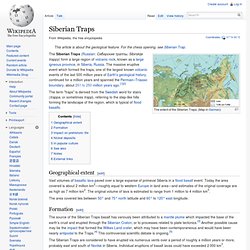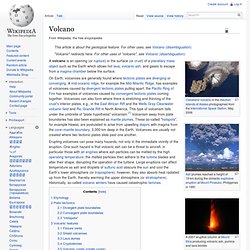

Magma. Magma is a complex high-temperature fluid substance.

Temperatures of most magmas are in the range 700 °C to 1300 °C (or 1300 °F to 2400 °F), but very rare carbonatite melts may be as cool as 600 °C, and komatiite melts may have been as hot as 1600 °C. Most are silicate mixtures. While the study of magma has historically relied on observing magma in the form of lava outflows, magma has been encountered in situ three times during drilling projects—twice in Iceland, and once in Hawaii.[3][4][5] Source[edit] Partial melting[edit] Melting of solid rocks to form magma is controlled by three physical parameters: its temperature, pressure, and composition. When rocks melt they do so incrementally and gradually; most rocks are made of several minerals, all of which have different melting points, and the physical/chemical relationships controlling melting are complex.
Geochemical implications of partial melting[edit] Pegmatite may be produced by low degrees of partial melting of the crust. SiO2 < 45% Volcanism. Plate tectonics map with volcano locations indicated with red circles.

Pressure in Mount Fuji is now higher than last eruption, warn experts. The pressure in Mount Fuji's magma chamber is now higher than it was in 1707, the last time the nearly 4,000-metre-high Japanese volcano erupted, causing volcanologists to speculate that a disaster is imminent.

The new readings, taken by the National Research Institute for Earth Science and Disaster Prevention, reveal that the pressure is at 1.6 megapascals, nearly 16 times the 0.1 megapascals it takes to trigger an eruption. This, lead volcanologist on the case Eisuke Fujita told Kyodo News, is "not a small figure". Don't miss: Geologists find fault system that could be first signs of future supercontinent Researchers have speculated for some time that the volcano, located on Honshu Island 100km southwest of Tokyo, is overdue an eruption. In 2000 and 2001 a series of low-frequency earthquakes were recorded beneath the volcano, leading to widespread predictions of an imminent blow. A 2004 government report originally estimated that an eruption would cost the country £19.6 billion.
Phlegraean Fields. Sulfur at the Solfatara crater Geological phases[edit] Three geological phases or periods are recognised and distinguished.[3] The First Phlegraean Period.

It is thought that the eruption of the Archiflegreo volcano occurred about 39.28 ± 0.11 ka. The dating of the Campanian Ignimbrite (CI) eruption to ~37,000 calendar years B.P. draws attention to the coincidence of this volcanic catastrophe and the suite of coeval, Late Pleistocene biocultural changes that occurred within and outside the Mediterranean region. Volcanic deposit indicating possible eruption dated Ar at 315, 205, 157 and 18.0 kya[citation needed] The caldera, which now is essentially at ground level, is accessible on foot. Wine[edit] Red Campi Flegrei is a blend of 50-70% Piedirosso, 10-30% Aglianico and/or Sciascinoso and up to 10% of other local (both red and white) grape varieties.
Cultural importance[edit] Campi Flegrei has had strategical and cultural importance. Siberian Traps. The extent of the Siberian Traps.

(Map in German) The Siberian Traps (Russian: Сибирские траппы, Sibirskije trappy) form a large region of volcanic rock, known as a large igneous province, in Siberia, Russia. The massive eruptive event which formed the traps, one of the largest known volcanic events of the last 500 million years of Earth's geological history, continued for a million years and spanned the Permian–Triassic boundary, about 251 to 250 million years ago.[1][2] The term "traps" is derived from the Swedish word for stairs (trappa, or sometimes trapp), referring to the step-like hills forming the landscape of the region, which is typical of flood basalts.
Geographical extent[edit] Vast volumes of basaltic lava paved over a large expanse of primeval Siberia in a flood basalt event. The area covered lies between 50° and 75° north latitude and 60° to 120° east longitude. Formation[edit] Impact on prehistoric life[edit] Nickel deposits[edit] In popular culture[edit] Volcano. A 2007 eruptive column at Mount Etna producing volcanic ash, pumice and lava bombs Santa Ana Volcano, El Salvador, a close up aerial view of the nested summit calderas and craters, along with the crater lake as seen from a United States Air Force C-130 Hercules flying above El Salvador.

Erupting volcanoes can pose many hazards, not only in the immediate vicinity of the eruption. One such hazard is that volcanic ash can be a threat to aircraft, in particular those with jet engines where ash particles can be melted by the high operating temperature; the melted particles then adhere to the turbine blades and alter their shape, disrupting the operation of the turbine. Large eruptions can affect temperature as ash and droplets of sulfuric acid obscure the sun and cool the Earth's lower atmosphere (or troposphere); however, they also absorb heat radiated up from the Earth, thereby warming the upper atmosphere (or stratosphere). Etymology Plate tectonics Divergent plate boundaries "Hotspots"